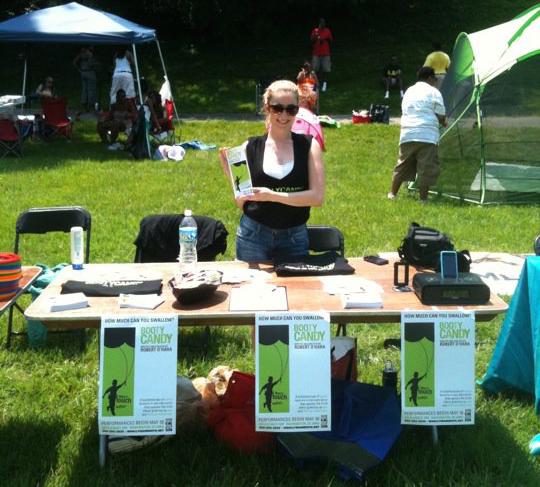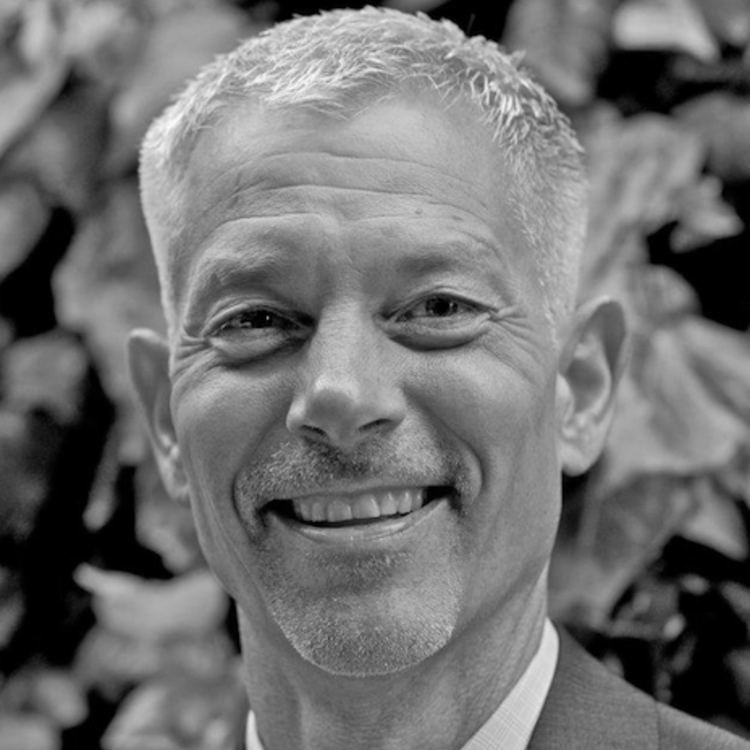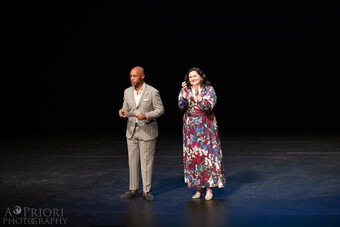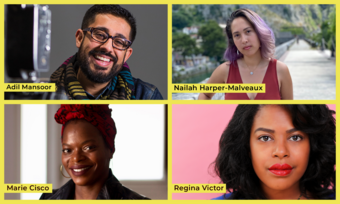Marketing Beyond the Bottom Line
Why the Division between Marketing and Engagement?
This week on HowlRound, we continue our series on Triple Play, a consortium project between Theatre Development Fund and Theatre Bay Area. Triple Play is exploring the crucial triangular relationship between playwrights, theatres, and audiences with the hope of creating a paradigm shift in the way the field thinks about audiences and the way audiences experience new work. Now in phase two, Triple Play is midway through 300 interviews between playwrights and audience members around the country. This series will share best practices in audience engagement and question how we define the relationship between artists, theatre companies, and audiences.—Alli Houseworth, series curator
Late May, 2011. Washington, DC. One of the hottest days on record; so hot you could feel the sweat drip between your shoulder blades all the way down your body until it tickled your calves. It was disgusting. My team and I stood behind a table in a park in Southeast, DC—the quadrant known for its poverty levels and its crime rates and its predominantly black population and its “you don’t go there” (until the condos started to come in)—and we stood there as the hip-hop blared from battery-powered boom boxes and smoke from the barbecue wafted through the air. We stood there, each and every one of us white as white can be, with one goal: get this crowd to come see our theatre’s production of Bootycandy.
At the time, I was the marketing director at Woolly Mammoth Theatre Company and our run of Robert O’Hara’s Bootycandy, the world premiere, began performances (coincidentally) the same week as DC’s Black Pride. I didn’t even know there was a Black Pride in DC until I started doing research on how to get an audience—the right audience—in to see this show, and I was born and raised in the area. Why didn’t I know? Probably because I’m a straight white female. Perhaps Black Pride isn’t meant for someone like me. I’m not the right audience.

On paper for a marketer, Bootycandy is problematic. Some local print publications wouldn’t run ads because of the title. The title also turned off the “traditional” theatregoing audience. People giggled when you said the name. The relatively unknown African-American playwright shared the same last name as one of our country’s most well-known female southern protagonists. The play was almost impossible to describe: a coming-of-age story about a black, gay kid? A story about how words and labels can wrongly define an identity? As a straight white female marketing director, what the hell did I know? I didn’t even know at the time that being gay in the African American community is a huge stigma. I was doomed.
One day in the first week of rehearsal I gathered my whole white marketing team to go down to the rehearsal room to talk to Robert O’Hara and the cast (all black except for one). We brought pens and notepads and I will never forget sitting on the floor of the rehearsal room with all of them; us saying, we don’t know this world, and them saying, we know you don’t; and them saying, let us help you, and us saying, we’re ready. They gave us names and contact information of friends, colleagues, organizations; they offered to do anything to help; they let us know where sensitivities lie; they said over and over again how important, what an honor, it was for them to be part of this storytelling experience. The more they spoke the more we felt the same, and then several weeks later we were in that park at Black Pride on one of the hottest days on record in low-cut v-neck t-shirts that said Bootycandy that were now soaked in sweat and we passed out condoms that had a discount code on the packaging and said, We know we don’t know this world, don’t know it at all, but we have a play that’s going on that’s about your world and we think it will really mean a lot to you if you saw it and we’d really like you to be there. We think it’s important. This play is for you.
When I first started this job, our board president at the time, Pete Miller, told me, “Your job—marketing new plays—is like doing a new product launch every six to eight weeks.” Pete, a former AOL executive and lifetime theatre lover, knew you couldn’t take the same marketing approach for every play and be successful. Not every play requires you to show up in neighborhoods you don’t know, and not every play requires a feature story in your city’s largest paper. New plays are hard. Like new products, new plays are unknown quantities. They’re not household names. There could be multiple iterations between when the proverbial “go button” is hit and when the actual go button is hit.
We were marketing plays, and plays are art. As art, a play’s purpose is to have an intrinsic impact on the audience. Plays—like all art—need to resonate in the moment and they need to resonate after. This is not something a screwdriver or a vacuum can deliver.
My primary responsibility at Woolly as the director of marketing and communications was to develop a marketing strategy for Bootycandy (and all of Woolly’s plays—most of which were new plays) that would result in us meeting our sales goal. But that wasn’t enough for me. My team wasn’t marketing a product. We were marketing plays, and plays are art. As art, a play’s purpose is to have an intrinsic impact on the audience. Plays—like all art—need to resonate in the moment and they need to resonate after. This is not something a screwdriver or a vacuum can deliver.
Although my “business” job as an arts marketer whose company produced new plays was to meet the sales goal, my “mission-driven” goal was to get the play in front of the audience with which it would most resonate. It was important to me. That goal wasn’t just my own, either—it was a core principle of the company’s newly-created department, Connectivity. I worked to close the loop between my “business” job and my mission-driven heart, and understood if I got the right audience to see the play, then the play would resonate more, it would have greater impact on the audience, and the greater impact would result in greater brand-trust, and then more sales. But first and foremost I had to meet the sales goal.
In the end, Bootycandy exceeded its sales goal, closed the highest-grossing season in Woolly’s history, and brought in what many stakeholders said was the most diverse audience the company had ever seen. I couldn’t have been more proud of my team, and everyone at the organization, for all the stops we pulled out to make that show shine.
Six weeks after Bootycandy closed, I left Woolly. I left one of the best jobs at one of the coolest theatre companies in the country because it was my job to focus on the bottom line and all I wanted to do was talk to, sit with, listen to the audience, and give them a fabulously challenging unforgettable experience. The work I led on that show—the creation of swag, humorous discounting, grassroots outreach, trivia nights at a gay bars, giveaways at Black Pride, dancing away at an African-American gay bar—the work I loved more than anything else, where you could look into the eyes of your audience (both potential and present), wasn’t my job. It was connectivity’s job.
As more and more companies create ‘audience engagement,’ ‘community outreach,’ and ‘community investment’ departments, but why are these positions housed in a department other than marketing?
To this day I still don’t understand why connectivity lived—and lives—in a separate department than marketing. And, there’s the rub—this isn’t just a Woolly thing. This is a field-wide issue.
I’m psyched to see more and more companies create “audience engagement,” “community outreach,” and “community investment” departments, but why are these positions housed in a department other than marketing? Yes, they may “talk all the time” and “give names to each other” and “create the necessary materials,” but if the two departments ultimately have the same goal, why are they not literally adjoined—by staff, budget, administration?
The end goal for all of us, field-wide, is to have an audience. You literally cannot do theatre without an audience. Within the theatre, the marketer’s primary responsibility is to generate earned income. Most of the time this is done through ticket sales, though it can include concessions and merchandise as well. Aside from a product to sell, the thing the marketer needs in order to reach the goal of generating earned income is an audience—consumers, people to make those purchases. Therefore, we can say a marketer’s job is to attract an audience. Once that audience is attracted, earned income can be generated.
Getting Them In the Door
But how does the marketer attract an audience? There are many ways: advertising, press, group sales, electronic media, outreach, and engagement. Each of these is a strategy a marketer uses to attract an audience. The advertising strategy will use the tools and tactics of print or web advertising to reach an audience. The electronic media strategy will use the tools and tactics of email and social media to reach an audience. Your engagement strategy will use the tools and tactics of community outreach and lobby design to reach an audience. Because audience engagement is about reaching and connecting with audiences, it lives in the marketing family, just like how press and electronic media live in the marketing family because their goal—to reach audiences—is the same.
There are marketers that excel at press relations, marketers who excel at sales, and marketers who excel at audience engagement. Each and every one of these marketer’s work is about attracting an audience to the art. Some use tools that will get people to the art faster, and some will use tools that get “better” people to the art—those for whom the art will resonate with most. However, at the end of the day, no matter the tool, the entire marketing team is working towards funneling a potential audience to the art through a transaction to an experience.
The strategies needed to market a new play are different than those needed to market a musical or known quantity. Humans are naturally risk-adverse, afraid to spend their hard-earned money and precious time on something they don’t know. So, in order to attract an audience to a play we need to eliminate barriers to attendance and reduce the risk for the consumer. So how do we do this? A marketer’s greatest resource for understanding the play—from the impulse for its creation to the words on the page—is the source itself: the playwright.
The Playwright’s Role in Marketing
As my current career as a “marketing” consultant progresses, I confess to being baffled by the number of new play producers whose marketers don’t talk to the playwright as they are designing their marketing strategies. Why would you not use the most powerful tool at your disposal, the one who no matter how many drafts of a script are done or characters are cut, can always tell you the original intention of the play—what it really and truly is about?
Conversely, I’m equally astounded every time I hear a playwright say they don’t want to, or it’s not their job, to talk to the marketing staff. Aren’t we all working towards the same goal? Don’t we all want a house full of audience members for whom the work will resonate?
The New Play Audience
Finally, what about—the audience, the new play audience; these strange creatures who emerge from their homes, put down their phones, and sit in a dark place surrounded by strangers to hear a new story told by someone they’ve probably never heard of before. Aren’t these people just magnificent?
What if we, as writers, as arts-makers, turned towards them, welcomed them to our home away from home, watched them watch the play, and if we’re lucky, feel them transform even in the slightest—and feel ourselves transform too, standing opposite our audiences (both potential and present), vulnerable, ready to learn, knowing without them we are nothing.
***
Triple Play, a consortium project between Theatre Development Fund and Theatre Bay Area, is exploring the crucial triangular relationship between playwrights and other generative artists, theatres, and audiences with the hope of creating a paradigm shift in the way the field thinks about audiences and the way audiences experience new work.
For the rest of this week we’ll be sharing bright spots that emerged from a convening hosted by HowlRound that took place in Phase I of the Triple Play research. At this convening, seventy theatre professionals from across the country (artistic directors, executive directors, marketing directors, managing directors, playwrights, etc.) met to hear the early findings.
As you read this week’s posts, the Triple Play team is deep in Phase II of the project—one where playwrights and practitioners will interview new play audiences in six cities across the country. All of the findings from this work will be published in spring 2017, followed by a seven-city tour.
It is our intention that the practices shared this week will inspire you in your new play work, whether you be an artistic or managing director, on the marketing staff, a playwright, or, the most important job of all, an audience member.












Comments
The article is just the start of the conversation—we want to know what you think about this subject, too! HowlRound is a space for knowledge-sharing, and we welcome spirited, thoughtful, and on-topic dialogue. Find our full comments policy here
I have so many thoughts here, but the overriding one is gratitude that a substantive discussion on the central questions of this post has been initiated among thoughtful and experienced people in the work. One of my favorite aspects of HowlRound is the conversation, both here and in other platforms-- including the type of in-person convening Alli references in the article.
I am another voice in the "don't conflate audience engagement with marketing" and we are structured exactly the way you reference, Alli, at ArtEmerson.
So given that is my "come-from" on the topic, some notions as to how and why we operate as we do:
First, this discussion of the role of the organization is intrinsic to questions of structure and strategy.
At ArtsEmerson we ask ourselves two questions at every turn:
-- Is it to be done?
-- Is it ours to do?
The answers are found embedded in our mission and in our relationships. Unless each is "yes", we do not pick it up as our work.
So, while it is unquestionably something to be done- this effort to build deeper connections among wider communities of people with the art- I think the answer to the second question must vary by institution.
Not every institution is authentically engaged in authentic engagement.
For many, this is not their central work. And therefore, I would argue, it is not theirs to do. They could better serve the cause by supporting, and bringing light and attention to, those for whom it IS their central work and at which they are effective. Audience development of this sort, by any arts organization, builds demand for all arts organizations if it is done with integrity, tenacity, strategy, and generosity. When this work is seen as an ancillary activity, or needs to lead directly to a transaction to be judged a success, it only deepens arts' alienation from the daily lives of our neighbors.
People are pointing out that it is a two-way street. And I agree-- but that street has more the characteristics and requirements of a residential neighborhood with people living side-by-side for generations, all on a first name basis. It is not the sort of two-way street that's lined with strip malls and by-the-hour hotel rooms. We have to be in this work and these relationships for the long haul.
Which is why I started by saying it is not something every organization should be expected to do.
Michael describes something closer to what is "ours to do" at ArtsEmerson. Our mission is to foster civic transformation around race and class equity through shared experience of art and public dialogue. (Yes, it takes more than one time through that statement of understand it...)
This is a mission that instantly puts a lot of our work out past the specific instance of "the play". And that speaks to why we are structured as we are.
A core strategy for us in this effort at civic transformation is to create an audience for our downtown venues that fully, organically, and routinely approaches the cultural, demographic and economic diversity of the city. These spaces are for everyone, and when everyone is in them we can get to work on transforming our city. Co-existing with that is our strategy for programming them: to put the world on stage so that when people engage regularly with ArtsEmerson's shows they come to understand the many cultural come-froms of their fellow Bostonians.
We deploy all manner of assets and strategies to build this specific audience and to foster this civic transformation. We are working in partnership with a whole community of other civic actors, both arts and nonarts activists, to achieve and serve these goals. This is the work of our Audience Development manager, Akiba Abaka, and our Special Initiatives manager, Nicole Olusanya. The dialogues are the work of our Artistic Engagement manager, Kevin Becerra.
They are all at work seating the organization as a neighbor, a sometimes host and frequent guest, a citizen of a larger effort to transform the city. A core engagement strategy is to invite participation of many different communities with the assets and resources we manage on behalf of the effort, not just the plays. The team has us in many settings around the city and we have many different curators from different cultural and genre come-froms programming in our spaces. These Community Curators are doing their own programming, emanating from their understanding of their own communities, in our spaces. The fact that so many different come-froms are engaged in one set of venues downtown advances our mission.
At the same time we have huge venues to program (2100 total seats across four venues) and we need to sell tickets to the interested public in order to both sustain our programming AND to activate the mission-- since the art and dialogue require engaged audiences to launch the process of transformation we seek.
Our Marketing team runs our sales strategies and expresses our brand voice in the press, social media and public forums. Through these efforts we speak our values and our story into the marketplace. We develop and execute all the marketing strategies you are speaking about across a season that features between 12 - 18 titles each year. They are experienced at the transaction focused activities of which you speak and they are also full partners in the mission, vision, and values of the organization.
And to your point, we always start with a discussion with the artists. Or strive to- at times we get out of schedule synch and wind up playing catch up, but our efforts emanate from what the artists know of their own work.
Our Engagement Team, meanwhile, remains focused on our relationships and our value to our city. This team does not generally deal directly with the transactional elements. When we are moving people between the Engagement efforts and the Marketing efforts there is very intentional and sometimes messy coordination and collaboration to bridge the gap we have intentionally left between the two.
We are now enrolled in a campaign to move more people over this bridge- people who know us deeply and well from our time together in a range of contexts. But we are not looking to move people title by title, rather on the basis of our shared desire to see this transformation in our city, and a shared sense of the role of art in that effort. We are starting to speak with our audiences who primarily intersect with us through our Engagement efforts about the impact of their presence in the ArtsEmerson audience, generally-- not just when we think we are doing something they should see but any time we are doing something THEY see value in, along our shared desire for a different, more equitable, more inclusive, more resilient city of Boston.
So, for us, the distinctive differences between how our Marketing Team supports our mission and how our Engagement Team supports it is how we keep things straight both internally and externally. We are working to get better and more intuitive around the bridge building and collaboration, but I personally continue to find real value in the structural delineation.
I agree with you, Alli, that the fundamental focus and purpose of marketing is to attract an audience. That is true for us at ArtsEmerson. Without the audience, we cannot do what is ours that do.
Where I disagree is that I don't think this is generally the fundamental, or even principal purpose of Engagement. For ArtsEmerson, that would be connecting our organization to our neighbors' drive for a transformed city, and engaging the full range of assets, resources, and opportunities at ArtsEmerson with that effort.
David Dower
VP, Office of the Arts
Co-Artistic Director, ArtsEmerson
www.artsemerson.org
Hi Michael and Jay. Thanks for both of your thoughtful responses to Alli's article. Since one of the primary goals behind Triple Play is to spur more conversation about audiences and new work, we're really pleased that this series on HowlRound is doing just that. So thanks so much for diving in!
Both of you speak passionately about engagement work in communities, work that "goes beyond the theatre walls." Michael, you wonder if Triple Play is aware of the distinction (and aware of the value) of that kind of work vs. the meaning and value of engagement with the art being presented on stage. The simple is answer is a resounding, yes! We're guessing that part of the difficulty we're having as a field in discussing "engagement" is that we use the word for a multiplicity of purposes. Sometimes we mean "engagement" to signify the kind of efforts you both describe, of a theatre company (staff, artists) relating with community members outside of the theatre, being in dialogue with them, listening to them, working together on mutually meaningful projects, and maybe, maybe having that dialogue evolve into a new piece of theatrical presentation. At other times we as a field use "engagement" to mean how audiences are relating to the theatrical work on stage. So contextualization, discussion -- formal and informal -- around the piece itself, around the ideas and issues behind the work, around the artists, interaction between the audience members and the artists and with each other, again, all centered around the work on stage and the ideas it puts forward.
In Triple Play, when we speak of "engagement" it's mainly this second meaning that we have in mind -- audience engagement vs. community or civic engagement. Not that we don't value civic or community engagement -- indeed these efforts have come up time and again in our conversations around the country -- and not that we are trying to conflate audience engagement with community engagement. It's just that our focus in this project is on how we deepen the relevance of theatre to people's lives and our national dialogue, and the way in particular we are choosing to approach is this is by exploring how we can better attract and "engage" audiences with new work. Our hunch has been that there are answers to be uncovered in bringing audiences and generative artists in direct conversation utilizing theatre companies as a bridge (the "triangular relationship" behind the name "Triple Play"). We are interested in exploring how direct unmediated interaction between artists and audiences, partnering with theatre makers, could increase the appetite for new work. Looking at what happens when the artists go out into the community without regard to a specific theatre or piece of work would be another exciting exploration but it isn’t the scope of this project!
Thanks for everything you are doing to advance the field!
Brad Erickson and Tory Bailey
Jay speaks for me. I would add that I think the distinction is crucial for reasons you state in the article, alli- marketing's job is to build an audience. Engagement/Connectivity/Civic Practice is all about building the organization's potential to be a resource, a collaborative public good entity through acts of listening, participation and co-designed opportunities for local impact beyond the walls of the theater. Not every company does this work- they shouldn't have to, don't need to. But to say Marketing should live as a department indistinguishable from these other growing,often community-need focused approaches, is i think not helpful to the growing and evolving practices you are referencing. At the heart of your essay is the belief that your job is to get the play before people for whom you believe it will be important. And we as artists can believe/presume what we do will be important to others we don't know. But the work you are seeking to align marketing with most frequently, in its best iterations, operates from a different philosophical and values-based point of view- for an arts organization to speak and act in service to others, in ways that will be/are important others, we must be in deep dialogue and ongoing relationship with those others before we decide what and how we can make important contributions to them. Rather than do our thing and then say- hey, this will mean a lot to you...come to our house and see for yourself. That's not an invalid belief system- presenting and producing art across disciplines is mostly based in that system. But its different than the history and frequent practice of what you describe as engagement...I hope triple play is conscious and interested in this distinction, rather than try and force kinship amidst difference. Embrace the difference. Support models that allow collaboration without assuming or demanding alignment that will sand down jagged edges. The jagged edges are real, they are difficult, and they can be opportunities...
Hi Michael!! It's so good to hear from you! I'm so happy to have your voice here as I've always believed your work in this arena is so smart, and so good. Thank you!
I've written a couple responses to this and deleted them all (lol) because I keep going back to, "yup. heard."
AND, one thing that is resonating with me is the idea of intention. What is one's intention behind doing Engagement/Connectivity/Civic Practice work? What is the end goal? What does success look like? Does this work align with your mission AND does it support a healthy organization (from a business POV)?
I also love that you say this: "Not every company does this work- they shouldn't have to, don't need to." In trying to look at this through your eyes, perhaps the structure and thinking behind what I suggest lives with the "other companies," -- those whose intentions aren't solely to "build the organization's potential to be a resource, a collaborative public good entity through acts of listening, participation and co-designed opportunities for local impact beyond the walls of the theater."
Woof.
Thanks for your perspective on this! I have a deep respect for the experience you bring to the conversation. That said, as an engagement professional, I would like to offer that community engagement shouldn't always live in the marketing department because it's a burgeoning field that has a broader scope than just bringing in audience. I often describe my role as living at the intersection of marketing, development, and education. I'm certainly working with our marketing team to identify new audiences and connect with them about our programming. But I am also building bridges in our community and identifying partners that really have little to do with filling our seats. These partnerships might open up unearned revenue opportunities or initiate collaborations that operate on an in-kind basis. I'm also spearheading the efforts to educate our community about our art form and the issues we are addressing with our programming. That education component is a two-way street though, as I am also doing my best to educate our organization about our community and the audiences within it. So, the scope of that role, to borrow Woolly's term, is a connective one -- not just between the organization and the community, but between various departments within the organization itself. The balance between those components is going to vary from organization to organization, and even from season to season within the same organization. I welcome your response to these thoughts. Thanks again for sharing!
Hi Jay! Thanks so much for your thoughtful comment. It sounds like you're doing great work. Your point "community engagement shouldn't always live in the marketing department because it's a burgeoning field that has a broader scope than just bringing in audience" is awesome for this discussion. In the spirit of discussion I'd ask back, "to what end?" Why do you - do many - build bridges and identify partners in a community? What is (are) the end goal(s) of that work? If we were to draw that as a huge arc, beginning with the intention of doing the bridge-building work and the partnership-development work, where does it end? Does it? Should it?